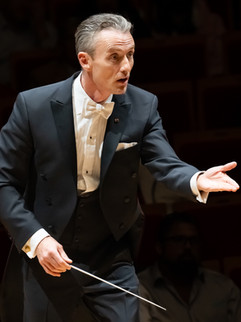The Pacific Symphony’s new music director gives us a chance to notice and understand the art of conducting anew.

It’s always big news when a symphony orchestra names a new music director, especially if the old music director has been with the orchestra for 35 years and has built it up from humble to major status. Perhaps you’ve heard about it amid the political din. The Pacific Symphony announced this week that Carl St.Clair will be stepping down as its music director, and 45-year-old British conductor Alexander Shelley will be stepping up. Our orchestra will never be the same.
But perhaps you’re also like a lot of people who don’t really quite know what a music director does, or who wonder if a conductor is all that important, or even necessary, for an orchestra to perform. After all, don’t the musicians all have the music right in front of them? I know many (otherwise) intelligent people who think along these lines and consider a conductor as little more than someone who dances in front of the orchestra, often badly, to the music as it’s being played.
There are orchestras, usually of smaller size, which do play without a conductor – the Orpheus Chamber Orchestra being probably the most well known. It can be done, and admirably. But what the Orpheus and other conductor-less ensembles do isn’t actually eliminating the job of conductor. It is taking that job and sharing it among the musicians collectively, in rehearsals and during performance. It is conducting by other means. What’s more, the results of such a method often seem devoid of a strong personal interpretive focus, which can be good or bad, depending on your point of view.
The rudiments of conducting – that is, keeping time – are easily taught. (Shelley himself has a series of short YouTube videos doing so.) There are set patterns for one, two, three and four (or more) beats to the bar and they are traced in the air, usually with a baton, at the tempo that is desired for the music to go. With these visual clues, the musicians, sometimes a hundred or more, know at what speed to play and what beat they’re on and can come together in synchronization as they perform. In a complex, intricately intertwined piece of symphonic music, this cannot be done by the musicians’ ears alone.
The first in a series of six videos posted on Alexander Shelley's YouTube page which showcase the skills of conducting. Video produced by Canada's National Arts Centre.
So much for the simple part. Conductors are far more than timekeepers, though; they are the interpreters of the music and, in a sense, are playing the orchestra as it performs. The score of a Beethoven symphony or any other musical work is not an exact recipe or computer code that duplicates itself every time. It is more like a script to a play, which the actors present each in their own way and a little differently every time.
We admire great actors and accept their creative artistry, even though they didn’t write the words they speak. We accept and reward great film directors, who shape movies and casts and productions that they didn’t create. In sports, quarterbacks are our most celebrated personages. Conductors do the same things — act, direct, lead.
Much of what conductors accomplish takes place in rehearsals, out of audience view. He or she will speak to the musicians about the music or sections of the music, then go over it, make adjustments, groom it. In the concert, their signals then remind the musicians of these interpretive decisions and a performance emerges. The conductor’s ears, not just the score, will be crucial in this process, as they listen to the music, musicians and the hall’s acoustics and make the thousands of adjustments needed to realize the vision of the score. The conductor Pierre Boulez was said to have two of the most acute ears in the business, able to detect the most infinitesimal defects in intonation and instrumental balances. In rehearsals, he would fix these and puzzle together performances of dazzling exactitude and clarity.
A conductor’s own temperament is reflected in his or her performances. You can hear something essential about the personalities of Arturo Toscanini, Leonard Bernstein, Carlos Kleiber, Otto Klemperer and many others in their recordings; indeed, you can sometimes identify conductors in recordings by the sound produced alone, lacking their name on the cover. Even a conductor without a strong temperament can produce his own sound. The early recordings of the taciturn Dutch conductor Bernard Haitink sound remarkably like the later ones.
The many expressions of Alexander Shelly conducting during his tryout performance with the Pacific Symphony in 2023. Photos courtesy of Pacific Symphony/Doug Gifford
The physical presence of conductors, their physique, their face, the way they give a beat, also plays a part. It cannot be otherwise, since the conductor’s art is largely a visual one. Shelley, tall and thin and elegant, has a distinctive little upward bounce in his beats, imparting a spark of energy into the music. St.Clair expresses his beats with a more dogged earnestness, urging and pushing the music forward.
The audience sees it too, and it influences how it hears what it is hearing. “It depends on the conductor’s personality,” Klemperer said, “and everything depends on that, even the visual. (Conductor Arthur) Nikisch, for instance, was an absolute beau. He had wonderful hands and always showed a lot of cuff – the black of his evening dress and the white of his cuffs was tremendously effective. There’s a lot of acting in conducting.”
And a lot of other things. We know little of Shelley now, but in concerts and seasons to come we’ll learn a lot more about him, through the music he conducts. That’s the joy and fascination of having a new music director. You get to know another human being, all while listening to great music. Perhaps you’ll fall in love, all over again.
Classical music coverage at Culture OC is supported in part by a grant from the Rubin Institute for Music Criticism. Culture OC makes all editorial decisions.



























.png)


